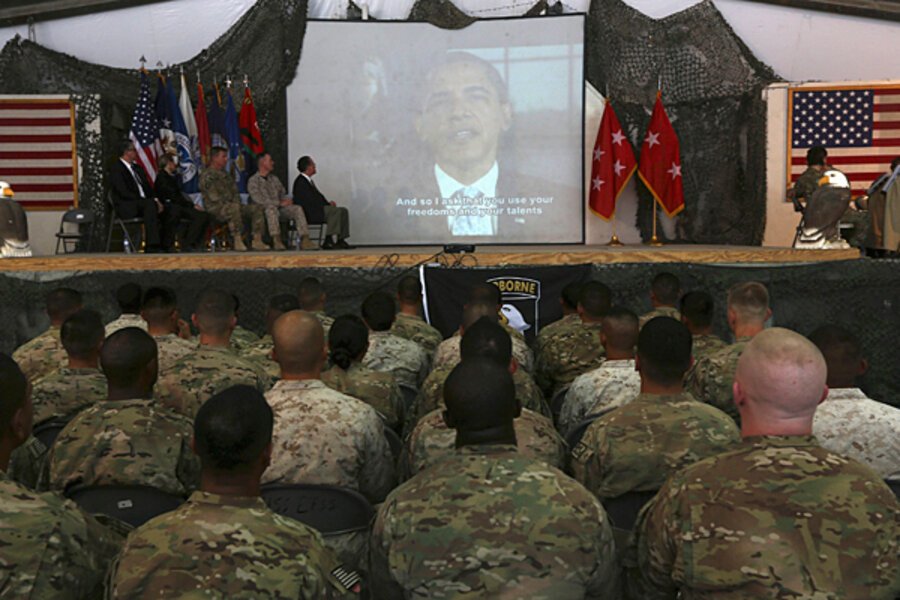Zero US troops in Afghanistan: real possibility or negotiating tactic?
Loading...
| Washington
The United States has two main objectives in Afghanistan after the US-led NATO mission ends in December 2014: to prevent Al Qaeda and other terrorist elements from regaining a toehold there from which to operate, and to continue training and building Afghan forces so they can maintain the country’s security and stability.
So then why does the notion that the US would leave no residual US forces continue to pop up, even as US officials and Afghan President Hamid Karzai undertake difficult negotiations over America's post-2014 presence? It's called the "zero option" – and it's getting fresh attention now for two key reasons, some US officials and Afghanistan analysts say.
One is that Mr. Obama has become more frustrated with the prickly Mr. Karzai, who in recent months has blasted the US over everything from its military tactics during ever-fewer operations to US efforts to launch negotiations with the Taliban, which the US drove out of power after the 9/11 terrorist attacks.
The other is the lesson of postwar Iraq. In that case, the US and Iraq were unable to agree on terms under which a residual US force would be stationed in postwar Iraq, and yet US officials' worst-case scenarios have not come to pass there.
The idea that the US could pursue its interests in Afghanistan, even without US troops on the ground there, has always been a possibility. The White House made that clear as far back as January, when Deputy National Security Adviser Ben Rhodes said, during one of Karzai's visits to Washington, that Obama “wouldn’t rule out any option” for a post-2014 residual US force, including the zero option.
But one reason the zero option is arising now, some analysts suggest, is that the US hopes it will jar Karzai into getting serious about hammering out an agreement on a post-2014 US military presence in Afghanistan. The idea is being floated at a time of high US frustration over Karzai's negotiating stance, they note, often with disapproval.
“I don’t agree with this negotiating tactic,” says Michael O’Hanlon, a military affairs expert at the Brookings Institution in Washington. Many Afghans are already concerned about the consequences of the ongoing US and NATO troop drawdown, and talk of a complete US departure – and of a faster US exit than planned – could cause some to reassess their futures and even to leave the country, he says.
“An accelerated [US] rush for the exits will, among other things, risk a crisis of confidence among those very Afghans – future leaders, next-generation activists, reformers, women, and others – that we should be wanting to stand by in tough times,” Mr. O’Hanlon says.
The US is set to draw down its troops in Afghanistan from 63,000 currently to about 34,000 in February. That number is expected to remain stable to help provide security backup during the Afghan national elections planned for April and afterward to help guide Afghan security forces through the summer fighting season.
The White House has suggested that Obama would review the pace of the 2014 drawdown after this summer, to take into account the performance of Afghan forces in this year’s fighting season. But White House spokesman Jay Carney said Tuesday that decisions on US troop levels in Afghanistan are not “imminent.” Concerning any post-2014 residual US force, he noted that the US still has a “year and a half” to work that out with Afghan authorities.
Most military and Afghanistan experts say it would be difficult for the US to pursue its two core objectives – counterterrorism, and training and support of Afghan security forces – with no military presence other than perhaps a few hundred soldiers at the Embassy in Kabul.
“The downside challenges of pursuing our key interests while having no forces in the region are still immense,” says retired Lt. Gen. David Barno, who was the first commander of combined forces (US and NATO) in Afghanistan in 2003 and is now a senior fellow at the Center for a New American Security in Washington.
Without a residual force, the US would have no military presence in the broader Afghanistan-Pakistan region, he says. That would be a contrast to the Persian Gulf region, where the US maintains a substantial presence.
“The administration has talked about an ‘enduring presence’ in Afghanistan, but the objectives it has laid out would be much more difficult with zero troops,” Barno says.
The counterterrorism objective aimed at Al Qaeda would be “much more challenging and complex” if the US had to rely on offshore military resources, he says. Moreover, “day-to-day intelligence gathering,” a crucial activity, would be difficult to replace.
Barno also cautions against using postwar Iraq as a model for how the zero option might work in a postwar Afghanistan. “Iraq is a far more modern country” with a more extensive infrastructure, he says, not to mention that Iraq has oil income while Afghanistan “has no ability to generate significant income,” at least not until its mineral wealth can be tapped.
The US has no troops in Iraq because the Iraqi government ultimately would not accept immunity for US troops from local laws. Karzai’s resistance to granting immunity is what could doom any post-2014 US military presence in Afghanistan, he says.
“Legal immunity from Afghan law is a sine qua non for us,” Barno says.
If Afghans are worried about rising chatter concerning a zero option for US troops, Barno says, they should direct their objections about that outcome to their own officials negotiating a post-2014 agreement with the US.
“They need to make their concerns known to President Karzai,” he says.








